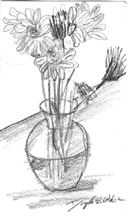
Looking more closely
October 17, 1999
Copyright 1999 Douglas E. Welch
Friend-LINK: <%=INSERTTEXT%>

A Gardener's Notebook:
The latest incarnation of my column detailing the trails and tribulations
of my garden. Join the list and ask your own questions about gardening
Subscribe
Gardens are a curious thing. Sometimes I am looking at my garden as a whole, trying to develop overall themes and designs. Sometimes I am focused on one plant as I move it from one area to another or try and nurture it back to health. Sometimes, though, I can go for weeks or months without ever really "seeing" my garden. I have several ways of re-connecting with my garden and one involves the combination of gardening with another of my hobbies, art.
 Drawing is seeing
Drawing is seeingAn ancient artist once said that you never really see anything unless you draw or paint it. The attention required in developing a representation of something requires us to regard it as never before. We alternately jump from the concrete to the abstract as we draw petal and leaf, root and branch. These mental leaps can lead us to a deeper understanding of whatever we are drawing.
I know what you are thinking. "I can't draw. I can't paint! He must be crazy!" While I am a little daft in some ways I have learned that anyone can draw and anyone can paint. More importantly, the level of your skill really doesn't matter at all. Just as a writer's journal is something private, your sketches can be for your eyes only. Even more, the act of drawing itself is more important than the results. The goal of sketching in the garden is to see things more clearly not necessarily make a perfect reproduction of them on paper.
If you are looking for an interesting garden party idea take a hint from an art coach friend of mine and schedule a "paint out." You can host a paint out in your own garden, a friend's garden or some public place. It is very simple to organize. Merely get a bunch of your friends together with pad and pencil and start to draw. You can each draw something different in the garden or you can all draw the same tree or plant. It is amazing how we can each see something different in the same rose, the same daisy, the same tree. Remember, the process is more important than the results. Notice how you approach the drawing. Are you drawing the plant or merely how you think the plant should be drawn? Look closely at whatever you are drawing but forget what it is . Instead of a petal it is a combination of pink and white light. Instead of a leaf, it is a construction of veins and edges.
 Sketch, don't shoot
Sketch, don't shootSketching can be especially useful when you are visiting gardens. Instead of taking photographs, make a sketch instead. You will be surprised at how much more you remember about the garden later. The act of sketching, like taking notes in class, helps to lock the memory tighter in our mind. It also helps to distill the scene into its more important parts. When sketching, we unconsciously and consciously leave out the lesser parts to concentrate on that which most interests us.
You don't need to go to the lengths of Monet, who created his own garden as a source for his artwork. Sketching and painting in your garden can open up a whole new world of possibilities for you, both in gardening and art.
If you would like to share your garden artwork, visit the AGN Community pages at http://www.onelist.com/community/agn and post your pictures to the FILES area. If you have pictures on your own web site, mail a link to the AGN discussion list and/or post a link to the AGN LINKS page also on the community site.
Until next week…
Keep digging (and sketching!)
Douglas E. Welch is a freelance writer and comptuer consultant
based in Van Nuys, California.
He can be reached at douglas@welchwrite.com or via his web pages at www.welchwrite.com.
<%=INSERTTEXT%>
|
<%=INSERTTEXT%> |